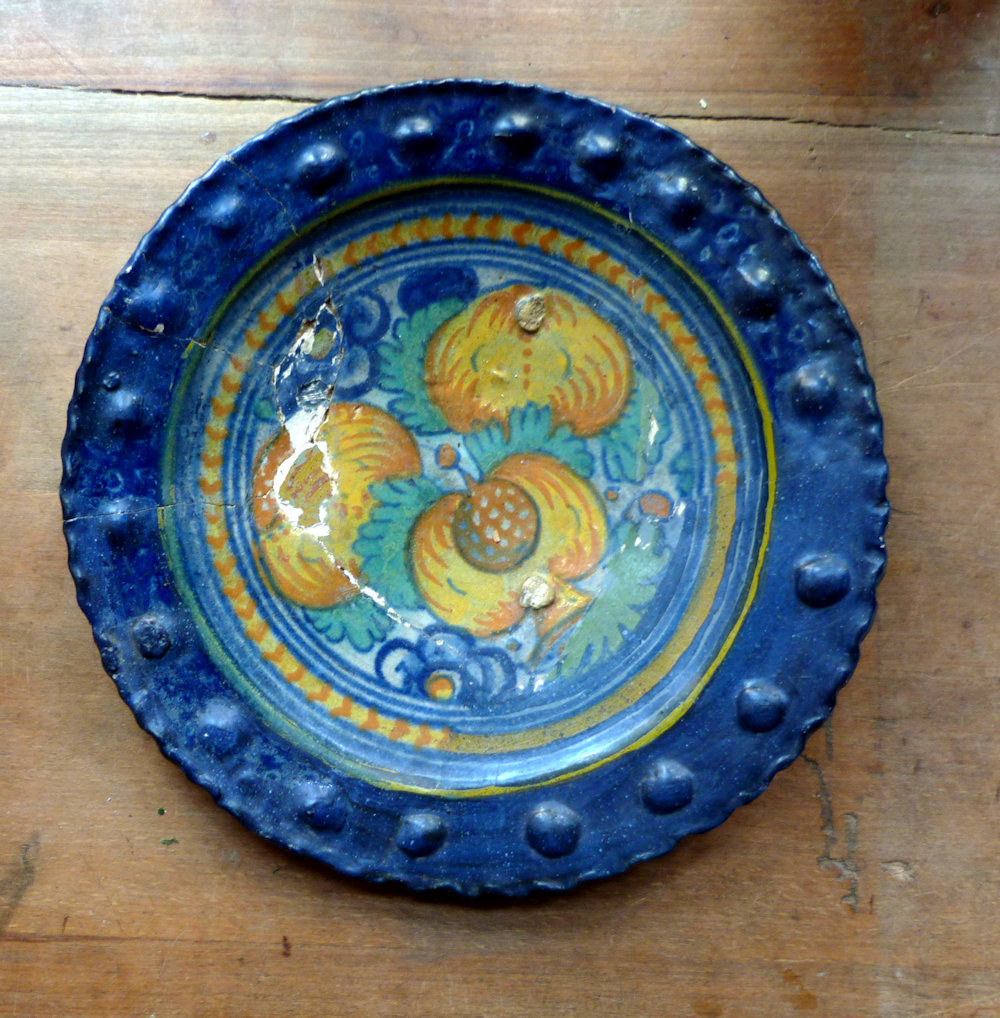
Flowers and Fruit on Ceramics
Redware pottery was usually undecorated. Slipware - in which tubular lines of a different type of clay are fired onto the redware base - was also made and used throughout Holland. The museumpiece shown here has an early depiction of a tulip, the new flower that was first grown in Holland in 1593 in Leiden University's botanical garden.
Holes on the back of the plate with pomegranate decoration show that the plate was intended to hang on the wall. Our plate was misfired, taking on a distorted and unusable shape. Thrown out by the potter, it was found on his discard heap in Leiden. The painting and the raised-disk ornament around the edge match the decoration on a bowl belonging to a family of Pilgrim descendants living in Kingston, Massachusetts, next to Plymouth. Their family tradition was that the bowl had been brought from Leiden by their ancestor on the "Fortune" in 1621. The plate from the Leiden potter's discards confirms the accuracy of that family tradition.

Tulips and an English Rose
The brass bed-warmer has tulips and an English rose in its pierced lid. Pottery fragments were heated in the fireplace to be put in the bed-warmer. Placed under the blankets, the bed-warmer could make the cold bedding less frigid. The combination of tulips and an English rose may refer to a marriage between members of the Dutch House of Orange and the English royal family. In 1640, Stadholder Willem II, Prince of Orange, married Mary Stuart, daughter of King Charles I. In 1677, Stadholder Willem III, Prince of Orange, married Mary Stuart, daughter of the Duke of York, who later became King James II. The Glorious Revolution deposed James II and put this second pair of William and Mary on the throne(s) as joint sovereigns of England in 1689.
Three examples of bed-warmers with this pattern are known - ours, another (in coper) in Leiden's St. Anna Hofje (almshouse), and a third in the collections of the Openair Museum at Arnhem.

Maize
Dutch flower paintings testify to a widespread custom of bringing natural color into seventeenth-century homes. While to us these plants principally represent a form of beauty to be enjoyed by the eye, to the Pilgrims and their contemporaries many of the flowering plants also were understood to have uses that we have generally forgotten or rejected as unproven nonsense. New plants from the New World might prove valuable for a wide variety of reasons, from nutrician to medicine. The nature and strength of Indian corn had not yet been determined. The value of other plants was well established. The root of narcissus, mixed with nettle seed and vinegar, for example, could be used to get rid of freckles.
The Pilgrims' source for such wisdom was a book they took with them to New England - Rembout Dodoens' A NEVV HERBAL, OR HISTORIE OF PLANTS (English translation, 1619, of a Dutch book from 1554). This book shows up in the inventory of the estate of Myles Standish as "Dodines earball." Dodoens had been the first hortulanus (chief gardener) of the Leiden University botanical gardens (Hortus Botanicus). After his death, his work, which was a compilation of all established botanical knowledge, was expanded by his successor Carolus Clusius. The new editions included information about the most recent discoveries of plants from distant regions just reached by European explorers.
Of particular interest in the Pilgrim story is the presence, already in the 1554 edition, of a clear depiction and description of Indian corn. Uniquely, on Indian corn the flower appears at a location distant from the fruit, an oddity that attracted the notice of many horticulturalists. By 1619, the newest editions of Dodoens' Herbal included a recipe for corn bread that suggested the cornmeal be mixed, half and half, with European wheat to lighten the bread. In 1554 Dodoens explained the name "Indian corn" for the plant then also known as "Turkish corn." The plant, he said, originated in India (or Arabia, known by the Romans as part of India). Later, Dodoens changed his mind, wondering if this plant was indeed the same plant from India that had been described by Pliny. Dodoens suggested that it should be properly called "maize" - a word used for it by Central American "Indians." A recent import to northern Europe, Dodoens commented that such corn could be found in the gardens of many collectors of plants. When the Pilgrims lived in Leiden, Indian corn could be seen in the university's botanical garden.
William Bradford commented that the Pilgrims had not previously seen corn as big as what they found when exploring Cape Cod in late 1620. They already knew what the plant was, before they made contact with any Native Americans; they had seen Indian corn before, in Leiden.

Flowers and Fruit as Decoration
Down the street from the museum, the twice-weekly market provides us with ever changing flowers throughout the year. Many of these flowers, like the tulips seen through the museum window, are modern varieties of plants the Pilgrims knew, and which we see as decorative patterns on objects that surrounded the Pilgrims living in Leiden.
Across the street from the Pieterskerk, the Jean Pesijnshof (almshouse) stands since 1683 where John Robinson lived from 1609 until his death in 1625. In the 1970s, water pipes were installed in the almshouse. Below the 1683 floor, tiles that had formed a baseboard around the walls of Robinson's rooms were fragmentarily recovered. These pictures show two of those tiles from the Pilgrims' house called De Groene Poort (The Green Close). Next to the fragments, complete tiles show the entire pattern.